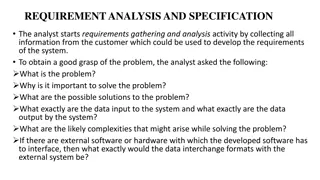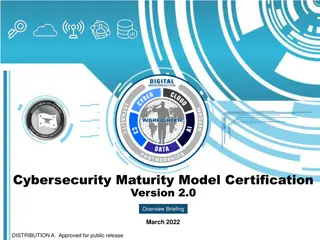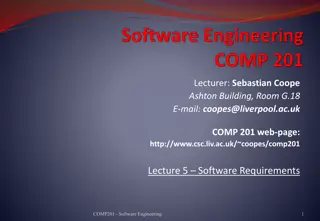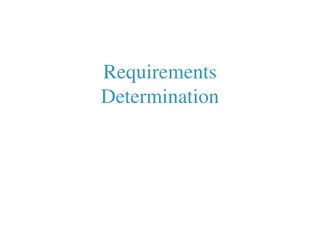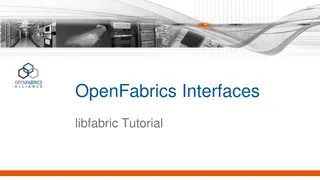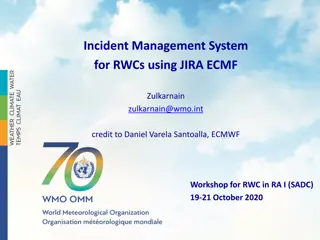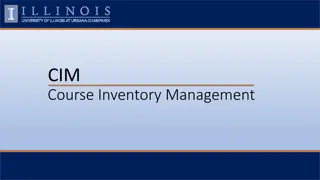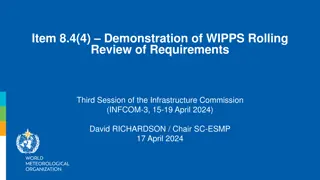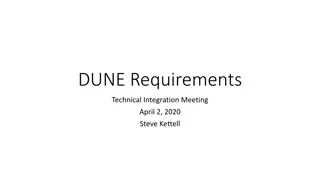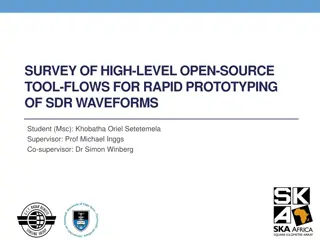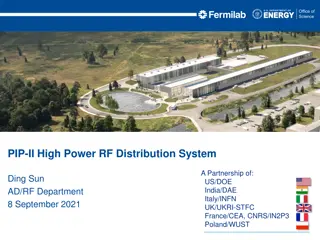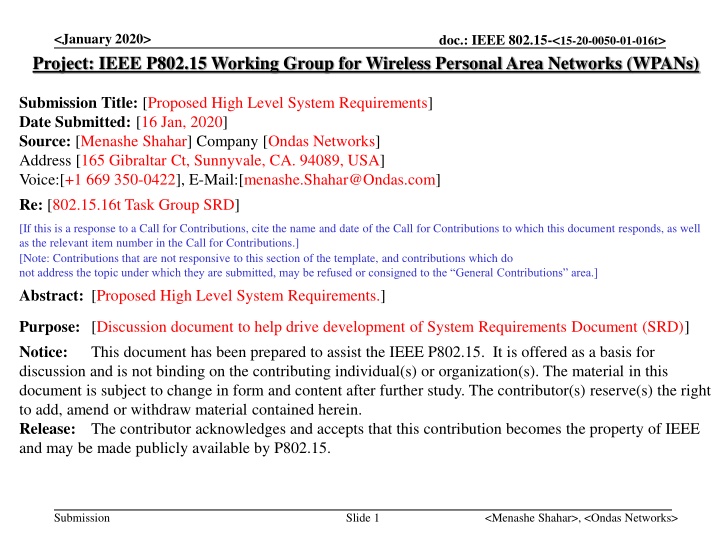
802.16t Wireless Communication System Requirements
"Explore the proposed high-level system requirements for IEEE 802.16t, a standard air interface protocol catering to long-range wireless communication needs of mission-critical sectors like utilities, government, and more. Learn about massive connectivity, throughput, latency, and application focus for this upcoming standard."
Download Presentation

Please find below an Image/Link to download the presentation.
The content on the website is provided AS IS for your information and personal use only. It may not be sold, licensed, or shared on other websites without obtaining consent from the author. If you encounter any issues during the download, it is possible that the publisher has removed the file from their server.
You are allowed to download the files provided on this website for personal or commercial use, subject to the condition that they are used lawfully. All files are the property of their respective owners.
The content on the website is provided AS IS for your information and personal use only. It may not be sold, licensed, or shared on other websites without obtaining consent from the author.
E N D
Presentation Transcript
<January 2020> Project: IEEE P802.15 Working Group for Wireless Personal Area Networks (WPANs) doc.: IEEE 802.15-<15-20-0050-01-016t> Submission Title: [Proposed High Level System Requirements] Date Submitted: [16 Jan, 2020] Source: [Menashe Shahar] Company [Ondas Networks] Address [165 Gibraltar Ct, Sunnyvale, CA. 94089, USA] Voice:[+1 669 350-0422], E-Mail:[menashe.Shahar@Ondas.com] Re: [802.15.16t Task Group SRD] [If this is a response to a Call for Contributions, cite the name and date of the Call for Contributions to which this document responds, as well as the relevant item number in the Call for Contributions.] [Note: Contributions that are not responsive to this section of the template, and contributions which do not address the topic under which they are submitted, may be refused or consigned to the General Contributions area.] Abstract: [Proposed High Level System Requirements.] Purpose: [Discussion document to help drive development of System Requirements Document (SRD)] Notice: This document has been prepared to assist the IEEE P802.15. It is offered as a basis for discussion and is not binding on the contributing individual(s) or organization(s). The material in this document is subject to change in form and content after further study. The contributor(s) reserve(s) the right to add, amend or withdraw material contained herein. Release: The contributor acknowledges and accepts that this contribution becomes the property of IEEE and may be made publicly available by P802.15. Submission Slide 1 <Menashe Shahar>, <Ondas Networks>
<January 2020> doc.: IEEE 802.15-<15-20-0050-01-016t> Proposed High Level System Requirements Menashe Shahar Ondas Networks Submission Slide 2 <Menashe Shahar>, <Ondas Networks>
<January 2020> Proposed High Level System Requirements for 802.16t doc.: IEEE 802.15-<15-20-0050-01-016t> 802.16t will be a standard air interface protocol focused on long range wireless communication requirements of mission critical organizations including electrical utilities, oil and gas, rails, UAVs, government security and others 802.16t will support a wide range of applications: Low throughput remote command and control applications referred to as Mission Critical Internet of Things (MC-IoT). These applications are best described by message length, periodicity, reliability, and latency in downlink and in uplink. Higher throughput applications, e.g. those data streaming (video/audio). These are best characterized by throughput, latency/jitter, and reliability in downlink and uplink. Note: 802.16t is an air interface protocol. As such, it is focused on interoperability between base stations and remote stations from multiple vendors. Product requirements which have no direct or indirect impact on the air interface protocol are not specified Submission Slide 3 <Menashe Shahar>, <Ondas Networks>
<January 2020> Proposed High Level System Requirements for 802.16t Support for 1000 s of endpoint devices per sector (known as massive connectivity ) in a Point to Multi-Point architecture An example of massive connectivity requirement includes rapid reconnection of all remotes in a sector after a base station failure has occurred. Throughput and latency requirements per endpoint: Many endpoints run low throughput, critical or non-critical latency applications. They should be served by low-end remote stations. Some endpoints run substantial throughput and sometimes also low latency applications. They should be served by high-end remote stations. The air interface protocol will support concurrent operation of both low- end and high-end remotes on the same sector / base station Low-end remote station specific requirements Limited throughput, Limited total bandwidth, Low power consumption, Low complexity Low-end device can trade off power consumption for latency High-end remote station specific requirements Support high throughput over relatively high total bandwidth. Supports low latency for time critical applications. doc.: IEEE 802.15-<15-20-0050-01-016t> Submission Slide 4 <Menashe Shahar>, <Ondas Networks>
<January 2020> doc.: IEEE 802.15-<15-20-0050-01-016t> Examples of Low Throughput Applications Solar Inverter Control (350 bytes every 5 sec) RR Crossing Control (15-20 bps) Drone Position Reports (tbd) Well Pump On/Off Control (tbd) Submission Slide 5 <Menashe Shahar>, <Ondas Networks>
<January 2020> doc.: IEEE 802.15-<15-20-0050-01-016t> Examples of Higher Throughput Applications Substation monitoring (1.4 Mbps) Video surveillance (throughput depends on resolution and frame rate) . Submission Slide 6 <Menashe Shahar>, <Ondas Networks>
<January 2020> doc.: IEEE 802.15-<15-20-0050-01-016t> General Requirements for 802.16t Mission Critical Related Requirements Predictable performance Licensed band (mandated by the PAR) Central scheduling QOS Latency requirements: TBD Frequency utilization requirements: TBD High Security Coverage requirements Long range single hop coverage (e.g., up to 50+ miles cell radius): Receiver sensitivity requirement TDD frame structure requirements Support of repeater for range extension (?) Reliability / Availability Mobility requirements Maximum speed: TBD Need to have actual use case requirements for mobility and if mobile, what is the speed? Level 1 fixed, handover only Level 2 nomadic, slow movement Level 3 Mobile: rapid movement - vehicular Submission Slide 7 <Menashe Shahar>, <Ondas Networks>
<January 2020> doc.: IEEE 802.15-<15-20-0050-01-016t> Spectrum Related Requirements for 802.16t Operation in paired or unpaired continuous licensed bands available for private networks (e.g., AMTS, IVDS, 454 A2G, 700 MHz A-Block, RR 900 MHz, 1.4 GHz). Support for partition of these bands into multiple channels is required for frequency reuse and link budget/coverage considerations. Operation in Private Land Mobile Radio (PLMR) bands (e.g., RR160 MHz). PLMR channels and bands are available worldwide. Common PLMR channel bandwidth: 6.25, 12.5, 25 and 50 kHz Special PLMR channel bandwidth: 5, 7.5 and 15 kHz Multiple adjacent or non-adjacent PLMR channels in the same band will be combined to support higher throughput services. Support of voice/data coexistence in low utilization voice channels. Voice will have priority over data. Case 1: The license is owned by the same entity for the voice and data Case 2: The voice license is owned by a different entity than the data system. Non-exclusive / shared use Submission Slide 8 <Menashe Shahar>, <Ondas Networks>
<January 2020> doc.: IEEE 802.15-<15-20-0050-01-016t> Duplexing Requirements for 802.16t TDD will be used in unpaired spectrum and in paired spectrum if allowed by the applicable regulation authority. A highly asymmetrical or reverse asymmetrical DL:UL ratio (e.g., 1:10 to 10:1) should be supported. Typical IoT application is highly reverse asymmetrical. HD-FDD or FDD will be used in paired spectrum if TDD is not allowed FDD will be used in paired spectrum if the latency requirements cannot be satisfied by TDD Submission Slide 9 <Menashe Shahar>, <Ondas Networks>



